 Index
Index

What every shoe designer should know.
Shoe design should be based primarily on the anatomy and the mechanical functionality of the human foot.
The second consideration should be the intended use of the footwear which will determine
the choice of materials and structure of the shoes. Finally, style and fashion
should influence the outward appearance of the shoe without compromising its comfort.

Foot Anatomy
The feet are very complex structures with many interdependent components.
The bones provide structural support. The heel bone or calcaneus adjoins
the tarsal and metatarsal bones which are fairly rigidly connected to each other and do not have much
movement at the joints. The metatarsals are joined to the phalanges or toe bones.
The joints between the metatarsals and the phalanges form the
ball of the foot which is very important for walking.
Ligaments and tendons hold the bones together and
control their range of movement. The Achilles tendon attaches the heel bone
to the calf muscles and is the most important tendon for walking, jumping, and running.
Nerves convey sensations from the sole and the toes,
and control muscle movements. Blood vessels provide nutrients to all the structures of the foot.
Mechanical Functionality of the Foot
The functions of the feet are to bear the weight of the body and provide locomotion.
While standing, the body is supported by both feet, and the weight is distributed between the
foot pads and the heels. A human footprint shows precisely which parts of the foot
support the weight of the body. The toes do not make much contact with the ground, but they
provide balance.
When walking, the complete weight of the body is placed on the heel during each step, and as the body moves forward, the weight shifts to the ball of the foot, and finally, to the toes. A running gait generally involves landing on the ball of the foot and not the heel. This allows the calf muscles to dampen the shock. Vigorous activities, like running or jumping, place additional pressure on the feet which may be equivalent to several times the body weight.
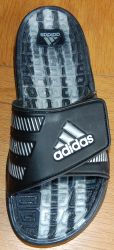
Mistakes in insole design
Adidas produces a variety of sport slide-style sandals under various trade names like
Santiossage, Calissage, Adissage, and Chayassage. These sandals are light, have adjustable velcro upper straps,
and have reflectorized strips to make them visible at night. The sandals also feature massage nubs
throughout the footbed that are supposed to provide relief for tired feet.
Unfortunately, the Adidas sports sandal illustrated here has an insole design
with widely-separated deep indentations which do not provide uniform
support for the load bearing surfaces of the foot, and the ridges that make contact with the
foot put too much pressure on the nerves and muscles in the ball of the foot.
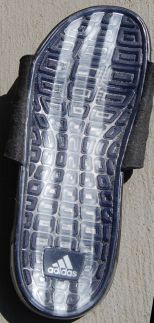
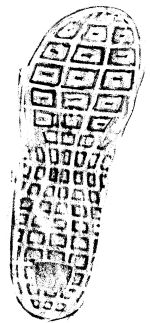
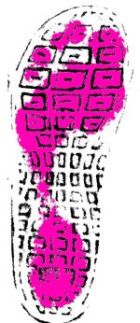
The basic mistake in the design of this insole is that the indentations are too deep (3 mm) and the ridges that support the foot are too far apart from each other (from 3 mm to 10 mm). In effect, the design reduces the area of the insole which supports the foot by 30% to 50%. The second problem is that the ridges supporting the weight of the body press directly against the nerves in the ball of the foot causing great discomfort when walking. It is useful to compare the insoles of a shoe to a bed of nails. When the nails are very closely spaced, a person can lie on a bed of nails without puncturing the skin because the weight of the body is distributed between many points of contact. If the nails were widely spaced, this would be very painful and dangerous.
The pictures above show the insole of the Adidas slipper, a charcoal rubbing of the design pattern, and an overlay of a footprint upon the insole design. The overlay makes it very evident that the largest gaps in the pattern are in the areas which should provide the greatest support. This is exactly the opposite of what is desirable. If the slipper designers had taken into consideration the shape of a human footprint, they would not have made this mistake.
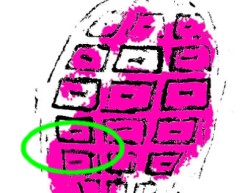
High heels and Pointed toes
Podiatrists (foot doctors) are kept in business by bad shoe designers, and
by women who, for the sake of fashion, wear uncomfortable high-heel pointed shoes.
Bad-fitting shoes are responsible for many types of foot problems such as blisters, calluses, corns,
ingrown nails, bunions and hammer toes.
Hallux valgus (bunion) deformities are caused primarily by pointed shoes
which force the big toe into an unnatural position and cause misalignment of
several bones in the forefoot. A hammer toe is a deformity of the second, third or fourth toes,
in which the toe is bent at the middle joint, so that it resembles a hammer.
Women's designer shoes with high heels and narrow toes force
the foot to slide toward the front of the shoe causing the toes to become deformed
from the pressure against the front of the shoe.
High heels also cause posture problems because they shift the center of gravity forward
and the spine has to compensate by bending backwards.
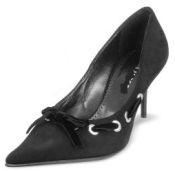
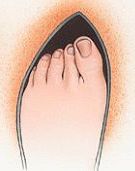
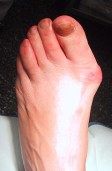
Low profile shoes
Shoes that don't provide enough room in the vertical direction will press the toe nails and the surface of the toes.
The pressure and abrasion can produce ingrown toe nails and foot corns. Corns (heloma durums) are calluses that usually form over
the joints and on the tips of the toes where the foot rubs against the shoe.
Wearing thick socks can provide some cushioning to reduce the pressure
on the foot and at the same time keep the inner lining of the shoe from rubbing against the toes. Sheer nylon hosiery
reduces the friction from rubbing, but it does not provide cushioning.


Boots
Boots are designed to cover the foot and the ankle. Boots have different functional purposes.
Boots can provide stability for the ankle to prevent sprains.
Other types of boots can protect the legs against snake bites or needles of thorny bushes.
Depending on their use, some boots may extend up to the knee or to the hip. These are the most common types of boots:

Gel insoles and Air soles
Gel insoles
and soles with air pockets provide cushioning and
minimize the shock of every step by distributing the weight over a larger surface of the foot.
This decreases the pressure per unit area and makes it more comfortable to walk or run.
The Ideal Shoe
Since different shoes are worn for different activities, there is no such thing as a "perfect"
shoe. A shoe that is perfect for hiking may not be a good shoe for running.
The design of a shoe has to take into consideration the task for which it will be worn.
A person involved in heavy lifting needs shoes with steel toes to protect the foot.
A runner needs light, well-ventilated shoes with soles that minimize impacts.
An office worker needs shoes that are comfortable and stylish.
Regardless of the application, the design of a shoe has to consider, first and foremost,
the anatomy and function of the human foot.
Sample Results:
Shoe-Design.com - Careers, Education & Trends - Designing Footwear
Shoe-Design.com is the home of the true shoe fanatic. Shoe trends, footwear design education and careers, footwear history and trivia, and anything else ...
www.shoe-design.com/
Shoe Design - The Art of Shoe Design & How to Become a Shoe Designer
Learn about the art of shoe design, and find information on how to become a shoe ... Become a Shoe Designer - Schools That Offer Courses in Shoe Design ...
shoes.about.com/od/shoe_design/Shoe_Design.htm
Become a Shoe Designer - Schools That Offer Courses in Shoe Design
Think you'd like to design shoes for a living? While there aren't a lot of colleges and universities that offer specific and comprehensive training in ...
shoes.about.com/od/shoe_design/a/shoe_design.htm
NIKEiD
Individually design your shoes, clothing, and equipment to match your style or improve your performance. Select the materials, choose the colors, ...
nikeid.nike.com/
Shoe and Footwear Designer
We are specialists in design, development, and manufacture of athletic, outdoor, and duty footwear. Together with our partner, Acts R&D Corporation ...
www.shoedesign.com/
Thong Sandal Fashion Shoes - Home
Spanisch Shoe Designer Spring Summer 2008 After designing during ten years for different brands as Camper, Antonio Miro or Jesús del Pozo . ...
www.thongsandal.com/
How to Become a Shoe Designer - Cobbler - Shoemaker, Starting a ...
Breaking Into and Succeeding as a Shoe Designer or Shoemaker ... As a shoe designer, you have the choice to design the following items using a variety of ...
www.stylecareer.com/shoe_designer.shtml